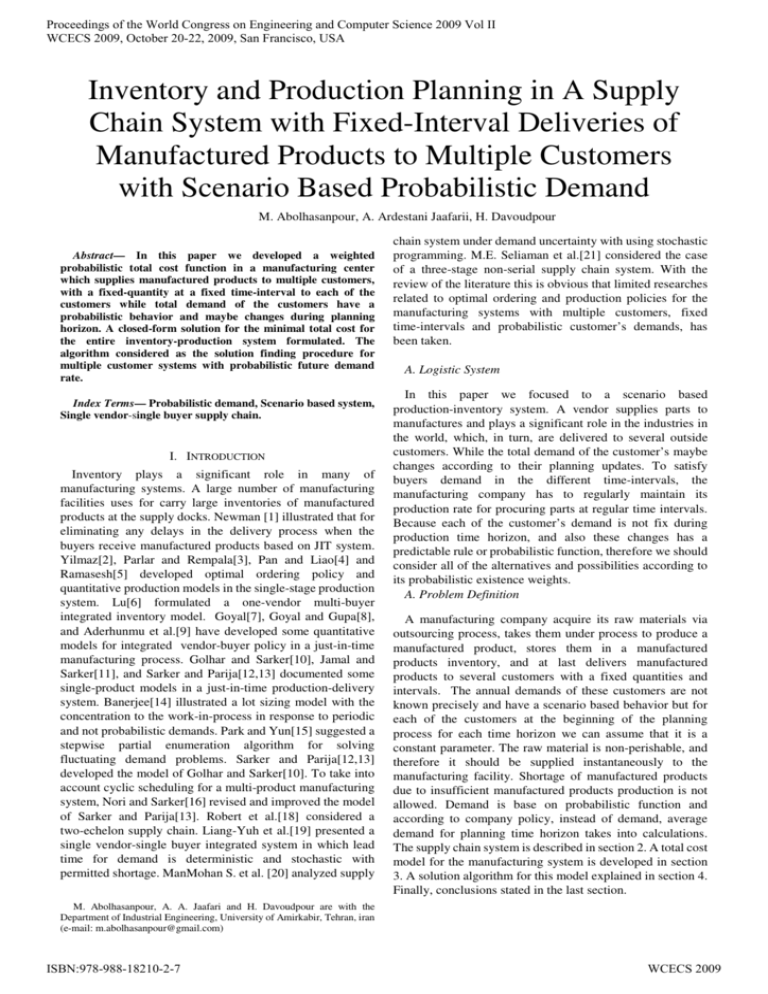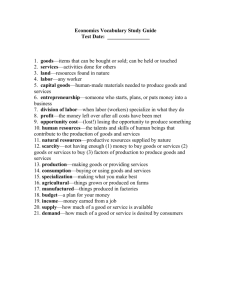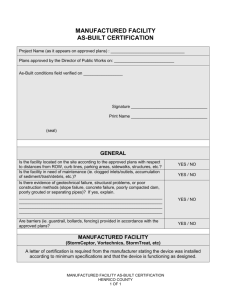Inventory and Production Planning in A Supply Chain System with
advertisement

Proceedings of the World Congress on Engineering and Computer Science 2009 Vol II
WCECS 2009, October 20-22, 2009, San Francisco, USA
Inventory and Production Planning in A Supply
Chain System with Fixed-Interval Deliveries of
Manufactured Products to Multiple Customers
with Scenario Based Probabilistic Demand
M. Abolhasanpour, A. Ardestani Jaafarii, H. Davoudpour
Abstract— In this paper we developed a weighted
probabilistic total cost function in a manufacturing center
which supplies manufactured products to multiple customers,
with a fixed-quantity at a fixed time-interval to each of the
customers while total demand of the customers have a
probabilistic behavior and maybe changes during planning
horizon. A closed-form solution for the minimal total cost for
the entire inventory-production system formulated. The
algorithm considered as the solution finding procedure for
multiple customer systems with probabilistic future demand
rate.
Index Terms— Probabilistic demand, Scenario based system,
Single vendor-single buyer supply chain.
I. INTRODUCTION
Inventory plays a significant role in many of
manufacturing systems. A large number of manufacturing
facilities uses for carry large inventories of manufactured
products at the supply docks. Newman [1] illustrated that for
eliminating any delays in the delivery process when the
buyers receive manufactured products based on JIT system.
Yilmaz[2], Parlar and Rempala[3], Pan and Liao[4] and
Ramasesh[5] developed optimal ordering policy and
quantitative production models in the single-stage production
system. Lu[6] formulated a one-vendor multi-buyer
integrated inventory model. Goyal[7], Goyal and Gupa[8],
and Aderhunmu et al.[9] have developed some quantitative
models for integrated vendor-buyer policy in a just-in-time
manufacturing process. Golhar and Sarker[10], Jamal and
Sarker[11], and Sarker and Parija[12,13] documented some
single-product models in a just-in-time production-delivery
system. Banerjee[14] illustrated a lot sizing model with the
concentration to the work-in-process in response to periodic
and not probabilistic demands. Park and Yun[15] suggested a
stepwise partial enumeration algorithm for solving
fluctuating demand problems. Sarker and Parija[12,13]
developed the model of Golhar and Sarker[10]. To take into
account cyclic scheduling for a multi-product manufacturing
system, Nori and Sarker[16] revised and improved the model
of Sarker and Parija[13]. Robert et al.[18] considered a
two-echelon supply chain. Liang-Yuh et al.[19] presented a
single vendor-single buyer integrated system in which lead
time for demand is deterministic and stochastic with
permitted shortage. ManMohan S. et al. [20] analyzed supply
chain system under demand uncertainty with using stochastic
programming. M.E. Seliaman et al.[21] considered the case
of a three-stage non-serial supply chain system. With the
review of the literature this is obvious that limited researches
related to optimal ordering and production policies for the
manufacturing systems with multiple customers, fixed
time-intervals and probabilistic customer’s demands, has
been taken.
A. Logistic System
In this paper we focused to a scenario based
production-inventory system. A vendor supplies parts to
manufactures and plays a significant role in the industries in
the world, which, in turn, are delivered to several outside
customers. While the total demand of the customer’s maybe
changes according to their planning updates. To satisfy
buyers demand in the different time-intervals, the
manufacturing company has to regularly maintain its
production rate for procuring parts at regular time intervals.
Because each of the customer’s demand is not fix during
production time horizon, and also these changes has a
predictable rule or probabilistic function, therefore we should
consider all of the alternatives and possibilities according to
its probabilistic existence weights.
A. Problem Definition
A manufacturing company acquire its raw materials via
outsourcing process, takes them under process to produce a
manufactured product, stores them in a manufactured
products inventory, and at last delivers manufactured
products to several customers with a fixed quantities and
intervals. The annual demands of these customers are not
known precisely and have a scenario based behavior but for
each of the customers at the beginning of the planning
process for each time horizon we can assume that it is a
constant parameter. The raw material is non-perishable, and
therefore it should be supplied instantaneously to the
manufacturing facility. Shortage of manufactured products
due to insufficient manufactured products production is not
allowed. Demand is base on probabilistic function and
according to company policy, instead of demand, average
demand for planning time horizon takes into calculations.
The supply chain system is described in section 2. A total cost
model for the manufacturing system is developed in section
3. A solution algorithm for this model explained in section 4.
Finally, conclusions stated in the last section.
M. Abolhasanpour, A. A. Jaafari and H. Davoudpour are with the
Department of Industrial Engineering, University of Amirkabir, Tehran, iran
(e-mail: m.abolhasanpour@gmail.com)
ISBN:978-988-18210-2-7
WCECS 2009
Proceedings of the World Congress on Engineering and Computer Science 2009 Vol II
WCECS 2009, October 20-22, 2009, San Francisco, USA
II. THE SUPPLY CHAIN SYSTEM
To find an Economic Order Quantity (EOQ) for the raw
materials and an Economic Manufacturing Quantity (EMQ)
for the production run, two types of inventory holding costs
are considered [17]: raw materials holding cost, H , and
manufactured products holding cost, H . Order costs includes
the ordering cost of the raw materials, K and the
manufacturing setup cost for each batch, K . Opportunity
cost, OC and extra sales cost, EC considered for illustrating
upper and lower demand situations costs. α, β, γ considered
as demand probabilities for three different states of the
customer’s demand. Following notation is used to model the
system:
A. Definitions and Notation
Raw material related: , , , , and .
Manufactured products related: , , , f, , , , P,
, , , , , , , , ), α, β, γ, ).
Cycle time related: , , , ! and " .
Definitions:
= quantity of raw materials required for each batch;
0
& 1 & + ;
2
= total quantity of manufactured products shipped, in
units/cycle;
.* = total quantity of manufactured products shipped by
time . ;
&
= cycle time;
01
31
& , While # ∈{1,...,N};
= production start time;
!
= manufacturing period (uptime);
"
= downtime;
"
&
/
!
!
& 7
&
!
31
01
5
!
;
/ 9;
8
= quantity of manufactured products shipped to customer
# at a fixed interval of time , units/shipment;
&
& , While # ∈ ?1, … , N@;
AB 5
= total demand for manufactured products by all
customers, units/year;
= quantity produced during period; = , &
= total demand for raw materials by the production
facility, units/year;
= opportunity cost for sale manufactured products when
demand for manufactured products (
) is more than it’s
calculated
average
(
* ), $/unit;
5
/ = (
, = total demand for manufactured products by
customer # , units/year;
$ = conversion factor of the raw materials to manufactured
products, $ =
/
;
= holding cost of manufactured products, $/unit/year;
= holding cost of raw materials, $/unit/year;
= given time between successive shipments of
manufactured products to customer # (# & 1, … , N*;
= number of full shipments of manufactured products to
customer # per cycle time ;
!;
= average inventory of manufactured products per
cycle, in units;
= quantity of manufactured products manufactured per
setup, units/batch;
- = quantity of manufactured products inventory held at the
end of uptime ! , in units;
.* = manufactured products inventory on hand at
time. ; .* & .* / .*
.* = quantity of manufactured products in the inventory
at time . , in units;
= quantity of raw materials ordered each time, units/order;
& /+ ;
ISBN:978-988-18210-2-7
= extra sale costs for sale manufactured products when
demand for manufactured products * is less than it’s
calculated average (
*), $/unit;
* = customer’s total demand probabilistic function;
= manufacturing setup cost per batch, $/batch;
, = production rate, units/year;
/ 1*
;
* = average total demand for manufactured products by
all customers, units/year;
= ordering cost of raw materials, $/order;
+ = number of orders of raw materials during the uptime
31
31
α = total customer’s demand probability when manufactured
products demand * is equal to average total demand for
manufactured products *, (
& **, 0≤α≤1;
β = total customer’s demand probability when manufactured
products demand * is less than average total demand for
manufactured products *, (
C **, 0≤β≤1;
γ = total customer’s demand probability when manufactured
products demand * is more than average total demand for
manufactured products
*, (
D **, 0≤γ≤1;
α + β + γ = 1.
B. The Supply Chain System
Manufactured products inventory in this model, doesn't
have equal behavior comparison with traditional economic
batch quantity model with continuous demand [13]. As
depicted in Fig. 1, to discourage the undesirable inventory
buildup, raw materials in this model are ordered + times
during the uptime. Because production rate, , , is
considered to be higher than the consumption rate, the
inventory will keep on building while the production (or
uptime) continues. A fluctuating-demand (fixed quantity) of
units of manufactured products at the end of every time
units to customer # , ( # & 1,2, … , N* , is imposed to the
manufacturer. This fluctuating demand decreases the
WCECS 2009
Proceedings of the World Congress on Engineering and Computer Science 2009 Vol II
WCECS 2009, October 20-22, 2009, San Francisco, USA
manufactured products inventory buildup instantaneously by
that makes as a result, an inventory buildup in an
increasing triangular fashion during the production period ! .
units of manufactured products, to satisfy the demand of
customer # at an interval of time units, are delivered
instantaneously that as a result remains / F units at hand,
where & , , the quantity that produced during time
units at the rate of , units per unit-time. The delivery
schedules of manufactured products and quantities shipped to
customer # ,(# & 1,2, … , N*, are also shown in Fig. 1. For
G customers ! C " C H C IJ! C I and all K , ( # &
1,2, … , N*, may not be equal and K ,(# & 1,2, … , N*, the
number of full shipments to customer # , is a non increasing
set of integer numbers (! ≥" D H D LJ! D L * such
that ! ! = " " & H & LJ! LJ! & L L &
. The
on-hand manufactured products inventory at any time . is
the manufactured products produced by that time minus the
total inventory delivered to all customers by time . . the
on-hand manufactured products at the end of uptime period
! , N , decrease instantaneously by K units at a regular
interval of K time units (after the production run) till the end
of the last shipment in a cycle are carried over to the next
cycle, resulting in a shifted production schedule as reflected
in Fig. 1.[17]
3
& 7 R 9 T
0S
0S UV JUW *
"X
.
(1)
Now, if there are + replenishments of raw materials during
the uptime period [ , ! Y, and transports of manufactured
products of size to customer # ,(# & 1,2, … , N*, during
the cycle time
, then, for , each batch required raw
materials, we can write & /+ and = ! / Q *, =
∑I
=
P! K K . therefore equation (1) could rewrite
as below:
Z3
! 0
3
& 7 R 9 T 7 R 9 7 1 9 . (2)
0R
" Z
5
A.2 Manufactured Products Costs
Because of probabilistic changes that exist in the demand
of manufactured products, three different demand states
maybe arise during the planning time horizon.
A.2.1 & *
When manufactured products demand ( * is equal to
expected value for manufactured products demand (
**,
we have this state for system costs (when
& * ).
3
3
Since R = 1 and = $ for a conversion factor (or
0R
01
production process efficiency) of raw materials to
manufactured products, $, the total cost for manufactured
products inventory for average inventory at a holding
cost $/unit/year can also be written as[17]
3
& 1 T . (3)
01
and the entire cost of the system may be expressed as
Z3
3
! 0
3
! , +* & 7 R 9 T 1 T 7 R 9 7 1 9 T
0R
01
" Z
5
0R
01
" Z
5
. (4)
Therefore, with replacing in equation (4) with the
results from what that stated by Sarker and Parija [17]:
Z3
3
! 0
3
! , +* & 7 R 9 T 1 T 7 R 9 7 1 9 T
[
Fig.1. Raw materials and manufactured products inventory
[17]
III. PRODUCTION COST MODEL
We assume that ! C " C H C IJ! C I . and to be
more confident in case of materials availability and proper
delivery, we further assume that & , ! / * &
& ∑I
& K K , While # ∈{1,2,…,N}.
P! K K and
A. Total Cost Functions
In the our model we assume that total future demand for
manufactured products is equal to demand probability
function expected value *. System has costs as below:
A.1. Raw Material Costs
In an inventory state where = , ! / Q * = =
∑I
P! K K , there might be some manufactured products hands
over to the next cycle after ∑I
P! K shipments to all
customers. A series of fluctuating deliveries of manufactured
products inventory continues after ! until the cycle repeats
same as what that done before. Thus the total cost of raw
materials, as stated with Sarker and Parija[13], is given by
ISBN:978-988-18210-2-7
]
\!J 1 _01
^
"
T
b
`BcV Aa
"
T
d .
(5)
A.2.2 C *
In this state manufactured products costs could formulate
as below:
3
& 1 T T * / ). (6)
01
Therefore, replacing in equation (6) with the results
from Sarker’s study[17] and with regarding raw material
costs from equation (2) in section 3.1.1 we have
[
" , +* & 7
]
\!J 1 _01
^
"
T
Z3R
0R
b
9 T
`BcV Aa
"
T
31
01
!
T 7
d 0R
" Z
97
31
5
9 T
T * / ).
(7)
A.2.3 D *
In this state manufactured products costs could formulate as
below:
3
& 1 T T * / ). (8)
01
Therefore, replacing in equation (8) with the results
from Sarker’s results[17] and with regarding raw material
costs from equation (2) in section 3.1.1 we have
WCECS 2009
Proceedings of the World Congress on Engineering and Computer Science 2009 Vol II
WCECS 2009, October 20-22, 2009, San Francisco, USA
[
e , +* & 7
]
\!J 1 _01
^
"
T
Z3R
0R
9 T
b
`BcV Aa
T
"
31
01
!
T 7
d 0R
" Z
97
31
5
9 T
T / **.
T & Min t
(9)
As mentioned, three different total cost functions as three
different scenarios exists for different states of the entire
system base on its total manufactured products demands.
Now, if ′ is a time such that C ′ , then must
satisfy[17]
I
′ / *, D ?`P! f ′ / Y @ While ′ D . (10)
That is, the quantity of manufactured products produced in
the time interval f , ′Y is sufficient to meet the demands
(shipments) for each individual customer until the time ′, at
all times ′ , after the product begins at .
Theorem 1. [17]
Aa
If & Min i ′ / ∑I
P! K 7 9j
5
Subject to ′ D ! , ′ / ≥ K D ′ / / 1 for
#&
1,2, … , G , and ′ : real, K : integer, then satisfies the
inequality (10). (11)
The lower bound on the integer variable K will be very
useful in actual computations. In theorem 1, illustrated that if
is chosen as stated, then meeting demands for all the
products will guarantee.
B. Start Time Determination[17]
The production start time, , can be determined by solving
the problem:
(PST): kl ,
I
Subject to m ′ / *, D ?`P! f ′ / Y @ , While ′ D
(12)
D 0.
This means that we would like to delay starting the
procurement and the production until it is absolutely
necessary. The constraint in problem (PST) implies that, if
i) The quantity of manufactured products produced in the
interval f , ′Y is ′ / *, ;
U′
ii) o q is the number of shipments for customer # until time,
′
pB
; l+r
U′
iii) o q is the total shipment quantity to customer # until
pB
time
′
,
Then the quantity produced in the interval f , ′Y is enough
to meet the demands for all the customers until time ′ . Note
that the constraint in (PST) can be written as : C
t
′
/u
b
`BcV vB AB
5
wx,
′
U′
D 0, =o q D 0,
equivalent to the inequality
C Min t
′
/u
b
`BcV vB AB
5
w│
0, #≥0 and integer. (14)
pB
U′
pB
D D
U′
pB
(13) which is
/ 1,
′
D
The right-hand side of inequality (13) is a Mixed-Integer
Programming (MIP) problem. Therefore, the upper bound on
is the solution of the MIP in inequality (13). Hence, the
optimal production start time T is given clearly by [17]
/u
b
`BcV vB AB
0, #≥0 and integer.
5
w│
(15)
U′
pB
D D
U′
pB
/ 1,
′
D
IV. SOLUTION ALGORITHM
Algorithm 1 as a strategy to arrive at a feasible solution for
this problem could be use.
Algorithm 1: solution algorithm
. 1. Compute by solving the MIP in (15)
. 2. Compute ! , +*, " , +* and e , +*.
. 3. Obtain probabilistic weighted total cost function
, , +** :
, , +* &
! , +* T " , +* T e , +**/
! , +*+ " , +*+ e , +*) (15)
. 4. Minimize , , +* over " to obtain (
, +)
. 5. Obtain a pragmatic solution:
(a) Generate two feasible integer solutions in the
neighborhood of ( , + ).
& max∑I
P! │ & constant for all #,
#&1G ##≤ , #:integer,
! & max∑I
P! │ & constant for all #,
#&1G ##≥ , #:integer,
+ = Integer n such that n minimizes │ ( /+* / /+ )
│, and
+! = Integer n such that n minimizes │ (! /+* / /+ )
│.
b* Choose the better of the two candidate solutions:
Optimum , +* = /+ ) where k = arg min {PWTC
( /+ ) , i = {0,1}}
V. CONCLUSION
The situation that developed in this paper was about
demand behavior. In the previous research demand
considered as a fix parameter that we manufacturer efforts to
balance its raw materials and manufactured products
inventory to achieve minimum total cost for the entire system
but in this paper we focused on the behavior of demand and
assumed that demand has a probabilistic scenario based
behavior and for each alternative we have an specified total
cost function that the goal of the model is to minimize the
probabilistic weighted total cost function for the entire
system Future researches can be directed to considering more
probabilistic sub-systems and factors in the different
combinations of inventory-production-sale or value chain
systems.
REFERENCES
[1]
[2]
[3]
[4]
ISBN:978-988-18210-2-7
′
Newman, R.G. (1988) the buyer-supplier relationship under just in
time. Production and Inventory Management, 29(3), 45-50.
Yilmaz, C. (1992) Incremental order quantity for the case of very
lumpy demand. International Journal of Production Economics, 26(3),
367-371.
Parlar, M. and Rempala, R. (1992) A stochastic inventory problem
with piecewise quadratic costs. International Journal of Production
Economics, 26(3), 327-332.
Pan, A.C. and Liao, C.J. (1989) An inventory model under just-in-time
purchasing agreements. Production and Inventory Management, 30(1),
49-52.
WCECS 2009
Proceedings of the World Congress on Engineering and Computer Science 2009 Vol II
WCECS 2009, October 20-22, 2009, San Francisco, USA
[5]
Ramasesh, R.V. (1990) Recasting the traditional inventory model to
implement just-in-time purchasing. Production and Inventory
Management, 31(1), 71-75.
[6] Lu, L. (1995) A one-vendor multi-buyer integrated inventory model.
European Journal of Operational Research, 81(3), 312-323.
[7] Goyal, S.K. (1995) A one-vendor multi-buyer integrated inventory
model: a comment. European Journal of Operational Research, 82(2),
209-210.
[8] Goyal, S.K. and Gupa, Y.P. (1989) Integrated inventory models: the
buyer-vendor coordination. European Journal of Operational Research,
41(2), 38-42.
[9] Aderohunmu, R., Mobolurin, A. and Bryson, N. (1995) Joint
vendor-buyer policy in JIT manufacturing. Journal of the Operational
Research Society, 46(3), 375-385.
[10] Golhar, D.Y. and Sarker, B.R. (1992) Economic manufacturing
quantity in a just-in-time delivery system. International Journal of
Production Research, 30(5), 961-972.
[11] Jamal, A.M.M. and Sarker, B.R. (1993) An optimal batch size for a
production system operating under a just-in-time delivery system.
International Journal of Production Economics, 32(2), 255-260.
[12] Sarker, B.R. and Parija, G.R. (1994) An optimal batch size for a
production system operating uner fixed-quantity, periodic delivery
policy. Journal of Operational Research Society, 45(8), 891-900.
[13] Sarker, B.R. and Parija, G.R. (1996) Optimal batch size and raw
material ordering policy for a production system with a fixed-interval,
lumpy demand delivery system. European Journal of Operational
Research, 89(3), 593-608.
[14] Banerjee, A. (1992) Production lot sizing with work-in-process
considerations in response to periodic demand. International Journal of
Production Economics, 26(2), 145-151.
[15] Park, K.S. and Yun, D.K. (1984) A stepwise partial enumeration
algorithm for the economic lot scheduling problem. IIE Transactions,
16(4), 363-370.
[16] Nori, V.S. and Sarker, B.R. (1996) Cyclic scheduling for a
multi-product, single-facility production system operating under a
just-in-time policy. Journal of Operational Research Society, 47(7),
930-935.
[17] Sarker, B.R. and Parija, G.R. (1999) Operations planning in a supply
chain system with fixed-interval deliveries of finished goods to
multiple customers. IIE Transactions, 31(1), 1075-1082.
[18] Robert N. Boute , Stephen M. Disney, Marc R. Lambrecht, Benny Van
Houdt. (2007) An integrated production and inventory model to
dampen upstream demand variability in the supply chain. European
Journal of Operational Research, 178, 121–142.
[19] Liang-Yuh Ouyanga, Kun-Shan Wub, Chia-Huei Ho. (2004)
Integrated vendor–buyer cooperative models with stochastic demand
in controllable lead time. Int. J. Production Economics, 92, 255–266.
[20] ManMohan S.Sodhi, ChristopherS.Tang. (2007) Modeling
supply-chain planning under demand uncertainty using stochastic
programming: A survey motivated by asset–liability management. Int.
J. Production Economics, ARTICLE IN PRESS.
[21] ] M.E. Seliaman, Ab Rahman Ahmad. (2008) Optimizing inventory
decisions in a multi-stage supply chain under stochastic demands.
Applied Mathematics and Computation, 206, 538–542.
ISBN:978-988-18210-2-7
WCECS 2009







